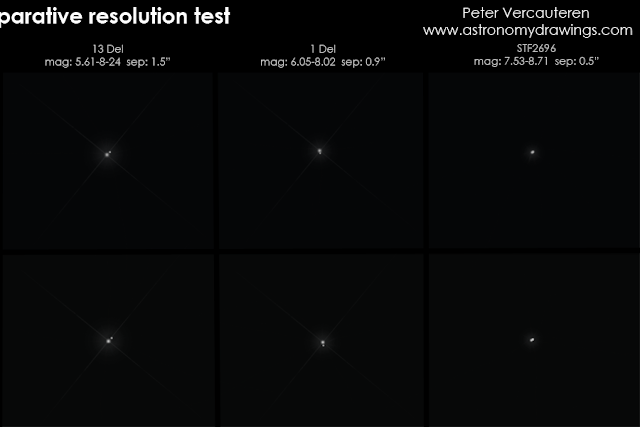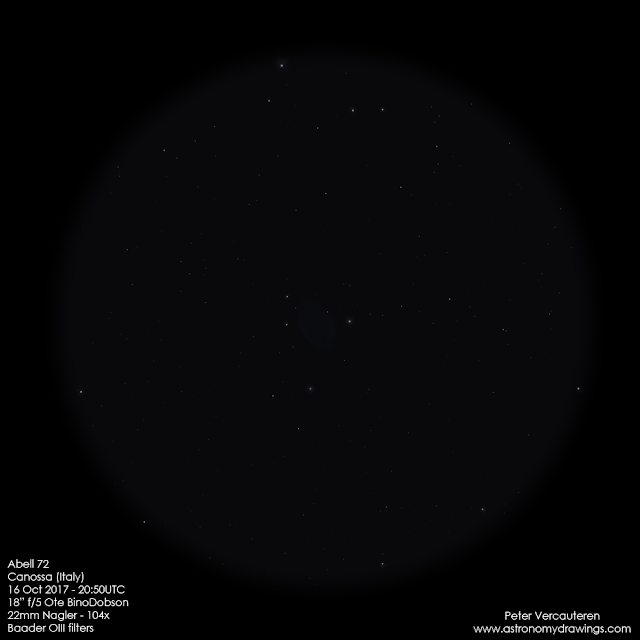How much more can you see with both eyes instead of only one? Or in
case of astronomers, how much more can you see with a binoscope
compared to a traditional monocular telescope?
It has been a heated debate for years, especially after someone
published the idea on Cloudynights, the world's biggest astronomy
forum, that a binoscope performs only 1.18 times the diameter of a
telescope with one identical lens or mirror. In other words, the
difference between a traditional telescope and a binoscope would be
insignificantly small. Compare it to a C8 and a (hypothetical) C9.5.
The reasoning seems logical at first sight, because it's based
on the old binocular summation factor that was established by
Campbell and Green in 1965. Their study revealed that people have a
1.41x better light signal perception with both eyes, compared to only one. A 41% increase in perception matches a telescope with a diameter only 1.18x
larger and voilà: a binoscope is a ludicrous instrument that costs
an awful lot of money and is impossibly big and complex for a
miserable gain.
I found this idea rather strange because my experience, and that
of everyone else who’s looked through a binoscope, showed that the
difference between one and both eyes is quite significant.
So where do we go wrong? First of all, a binoscope captures
twice the amount of light as a monoscope, hence it should be equal to
a telescope 1.41 times the diameter. That's a significant difference that
would match my observations. Critics, however, cite Campbell and Green and therefore state that our brain
doesn't simply mix both images into one and that there's a
performance loss, resulting in only 1.41x more light gathering power
instead of 2x. How odd! If the light of both mirrors were transferred
to one and the same eyepiece, they would undoubtedly agree that in that
case the performance of a binoscope would double, compared to a
monoscope.
The critics go wrong because they misinterpret the Campbell and Green
study. This study was meant for medical purposes and has no bearing
whatsoever on an astronomical environment, i.e. in the total dark
when observing at the limits. Pirenne already demonstrated in 1949
that there's no such thing as a single binocular summation factor and
that results may vary greatly with different circumstances. Meese et al. demonstrated in 2006 that the binocular summation factor may even increase to 1.7x in certain circumstances. Unfortunately, as I said, all of these studies were being conducted for medical purposes and no-one seems to be interested in doing a study for an astronomical audience. However, they all seem to agree on:
- There is no such thing as a single binocular summation factor and
that summation improves when conditions worsen (Pirenne, 1949)
- The extent of summation depends on stimulus contrast and duration (Bearse and Freeman, 1994)
- There is significant summation at low contrast (Banton and Levi, 1991)
- At low contrast, the level of summation is greater than could be
expected by probability summation alone (Simmons and Kingdom, 1988)
- Summation depends on the complexity of the task, with simple tasks
(detection) displaying far greater summation than complicated ones
(pattern recognition) (Frisen and Lindblom, 1988)
In contrast, a lot has already been written on the subject on the popular astronomy fora, especially in endless and meaningless yes/no debates. But what
does real experience tell us? Obviously, it would be impossible to do
a comparative limiting magnitude test because which stars would you
use as a reference? And what does “I've seen it” mean anyway?
You've seen it or you think you’ve seen it? Such comparisons would
never have any real scientific value unless you involve many people
and then take an average. I know that "impressions" don't mean much, but the difference with
closing one eye is simply too great and certainly much more than the
hardly visible 1.19x. Faint stars for instance suddenly disappear or
become very hard to see. With both eyes M104's dust lane suddenly
appears full of structures, which fade to a dark band with monocular
vision. With both eyes I see the Pillars of Creation in M16, whereas
they're invisible with one eye (under my SQM20.9 sky and with my eyes).
Nebulae appear so much brighter and richer in detail, faint galaxy
clusters suddenly become easy, "impossible" objects such as the
extremely faint planetary ARO215 suddenly become possible... An aperture
increase of only 19%? Nah, I don't buy it.
Another, even more controversial statement is that a binoscope not only offers a significant light gain, it also increases resolution. Well,... yes and no. Unfortunately an amateur binoscope doesn't work like professional compound telescopes such as NASA's Large Binocular Telescope. Each of my 18" mirrors delivers the resolution of an 18" and our brain isn't capable of extracting a higher resolution from both images. However... it does work the same way as photographers stack various images in order to extract more detail, up to the technical resolution limit of their instrument.
In order to demonstrate this, I’ve conducted a small experiment.
The other night the weather gods were in my favour because transparency was high and seeing was deliciously calm. I rolled out the binoscope and pointed it at a couple of double stars, some of which are
very close to one another. First, I used monocular view, in order
not to be biased, and then changed to binocular view. The results were astonishing. As you can see
on my sketch, the difference between a single 18” telescope and an
18” binoscope became ever more important as the two components
of the double star were closer to one another. 1 Del is pretty close with its separation of 0.9 arc-seconds, but binoscopic vision showed more black between both components than monocular view.
STF2696 was even more interesting. It is only 0.5 arc-seconds apart, which is very close to the 0.31 arc-second Rayleigh
limit of an 18” telescope. With one eye, I could only see one, elongated star, suggesting that it is a double without really being able to resolve it. With both eyes, on the other hand, both stars were clearly resolved and appeared to be glued to each other. The technical resolution of an amateur binoscope may not increase compared to an instrument with a similar single mirror, but this observation nonetheless confirms that binocular vision makes it easier to observe up to this technical resolution limit and that it will cancel out a large part of inhibiting factors such as atmospheric turbulences.
Of course, this was only a small, personal experiment and I will never pretend that it has any scientific value because, again, for that you'd need a lot of people of which a vast majority would have to confirm the same thing. But as far as I'm concerned, I'm convinced and will now leave the debating to others while I have some star gazing to do.




































